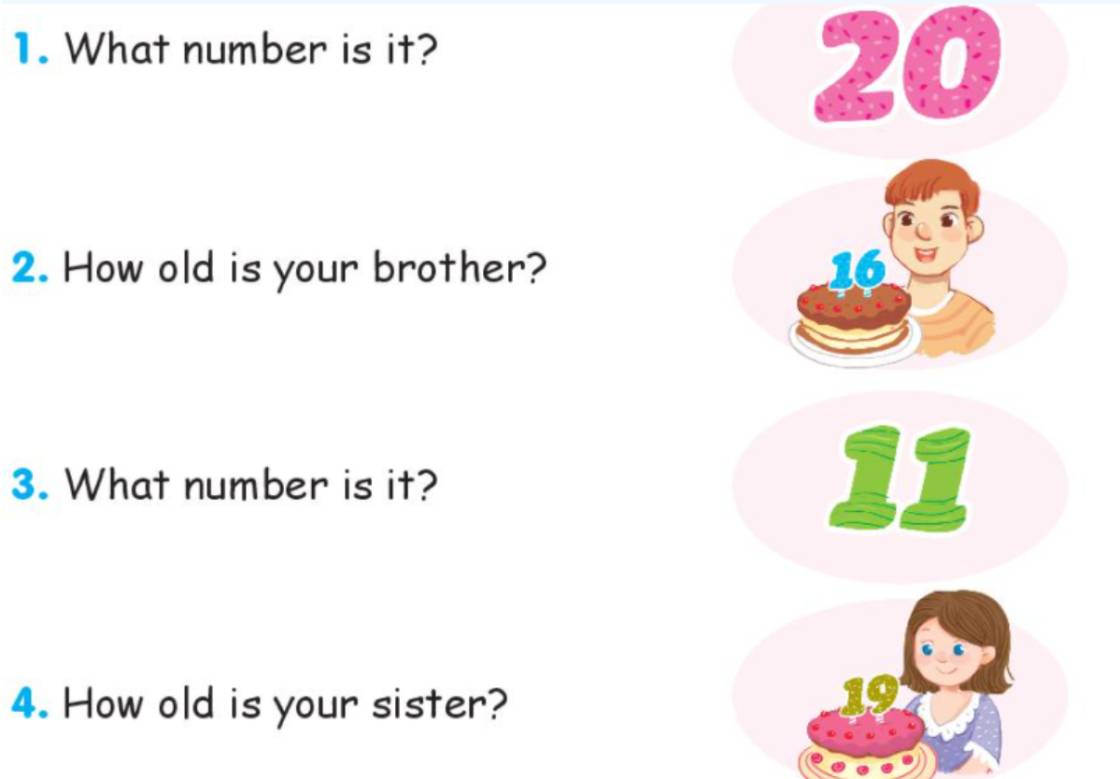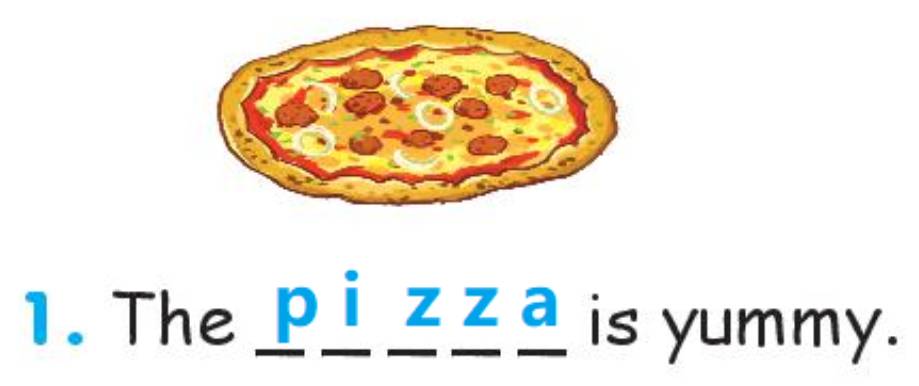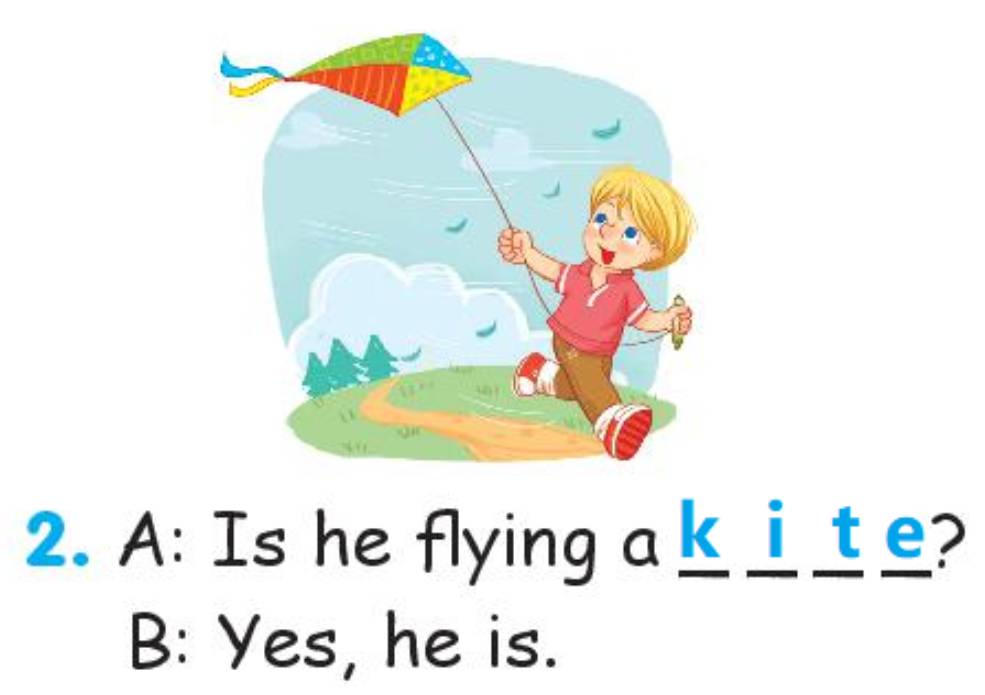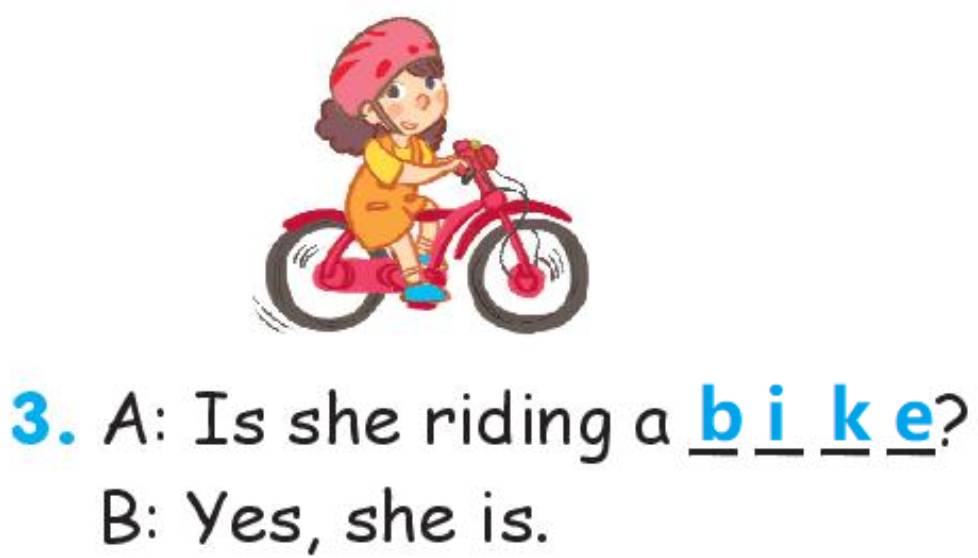Task 3. Look, read and answer.
(Nhìn, đọc và trả lời.)

Exercise 1. Look at the first photo and answer the questions. Then read the text and check your answers.
(Nhìn bức ảnh đầu tiên và trả lời câu hỏi. Sau đó đọc văn bản và kiểm tra câu trả lời của em.)

1. Where is Ben?
2. What is he doing?
I can still learn
Most children between five and eighteen in Britain must go to school. But the situation is different for me. I play tennis and I must practise a lot, and I often go to other countries to play in tournaments. How can I still learn? Luckily, digital learning helps me.
When I am absent from school, I do online courses. Computers help me with the subjects, and I can learn at my own speed. When there is no tournament, I come back to school and I can do the tests easily. My friends also help me if I have any problems.
This new learning way makes me happy and keeps me up with my friends. I can still learn when I am not at school. That is why digital learning becomes more and more popular.
* keep up with: to do whatever is necessary to stay level or equal with someone or something
1. Ben is at home.
(Ben đang ở đâu? – Ben đang ở nhà.)
2. He is studying.
(Bạn ấy đang làm gì? – Bạn ấy đang học.)
Tạm dịch văn bản:
Tôi vẫn có thể học
Hầu hết trẻ em từ 5 đến 18 tuổi ở Anh phải đến trường. Nhưng trường hợp của tôi thì khác. Tôi chơi quần vợt và tôi phải luyện tập rất nhiều, và tôi thường đến các quốc gia khác để thi đấu trong các giải đấu. Làm thế nào tôi vẫn có thể học được? May mắn thay, học tập kỹ thuật số giúp tôi.
Khi tôi nghỉ học, tôi tham gia các khóa học trực tuyến. Máy tính giúp tôi giải các môn học và tôi có thể học với tốc độ của riêng mình. Khi không có giải đấu, tôi trở lại trường và tôi có thể làm các bài kiểm tra một cách dễ dàng. Bạn bè của tôi cũng giúp tôi nếu tôi có bất kỳ vấn đề nào.
Cách học mới này giúp tôi cảm thấy vui vẻ và theo kịp bạn bè. Tôi vẫn có thể học khi tôi không ở trường. Đó là lý do tại sao học kỹ thuật số ngày càng trở nên phổ biến.
* theo kịp: làm bất cứ điều gì cần thiết để duy trì mức độ hoặc bằng với ai đó hoặc điều gì đó
Look and read. Choose the correct answer (A, B, or C).
(Nhìn và đọc. Chọn câu trả lời chính xác A, B hoặc C.)
Adventure Forest (Rừng thám hiểm) Outdoor activities! (Các hoạt động ngoài trời!) Stay at our campsite! (Ở lại điểm cắm trại!) Only thirty minutes away from Greenwood town! (Chỉ cách thị trấn Greenwood 30 phút!) |
Campsite Notice (Thông báo của điểm cắm trại) Campers, please remember to bring flashlights so you can see after dark. You can buy batteries at the store. (Người cắm trại, làm ơn hãy nhớ mang theo đèn pin để các bạn có thể nhìn thấy sau khi trời tối. Bạn có thể mua pin ở cửa hang.) |
Kayaking in the bay - Ages 10+ (Đi thuyền Kayaking trong vịnh – Từ 10 tuổi trở lên) River Rafting - 4 people max. At least one adult. (Đi bè trên song – tối đa 4 người. Ít nhất 1 người lớn.) |
Hey, April, (Chào April,) Adventure Forest is great. There are so many fun activities! But you shouldn't go in the winter because of the bad weather. Have a great time! (Rừng thám hiểm rất tuyệt! Có nhiều hoạt động vui nhộn! Nhưng bạn không nên đi vào mùa đông bởi vì thời tiết xấu. Chúc bạn có thời gian vui vẻ nhé! Joe. |
Example: (Ví dụ)
0. Go to the Adventure Forest if you want to...
(Hãy đến Rừng Thám hiểm nếu bạn muốn...)
A. go somewhere close to town. (đi nơi nào đó gần thị trấn.)
B. sleep comfortably. (ngủ một cách thoải mái.)
C. play indoor games. (chơi các trò chơi trong nhà.)
1. A. Campers have to bring batteries. (Người đi cắm trại phải mang pin.)
B. Campers can buy flastlight there. (Người đi cắm trại có thể mua đèn ở đó.)
C. Campers need flastlight to see at night. (Người đi cắm trại cần đèn để soi ban đêm.)
2. A. Anyone can do the activities. (Mọi người có thể làm mọi hoạt động.)
B. Children under 10 year old can’t go kayaking. (Trẻ em dưới 10 tuổi không thể đi thuyền kayaking.)
C. River rafting is for aldult only. (Chèo thuyền chỉ dành cho người lớn.)
3. A. The weather is very nice in the winter. (Thời tiết rất đẹp vào mùa đông.)
B. There isn’t much to do. (Không có gì để làm.)
C. Joe think April should go to Adventure Forest. (Joe nghĩ Tháng tư nên đi rừng Adventure.)
0. Go to the Adventure Forest if you want to...
(Hãy đến Rừng Thám hiểm nếu bạn muốn...)
A. go somewhere close to town. (đi nơi nào đó gần thị trấn.)
B. sleep comfortably. (ngủ một cách thoải mái.)
C. play indoor games. (chơi các trò chơi trong nhà.)
1. A. Campers have to bring batteries. (Người đi cắm trại phải mang pin.)
B. Campers can buy flastlight there. (Người đi cắm trại có thể mua đèn ở đó.)
C. Campers need flastlight to see at night. (Người đi cắm trại cần đèn để soi ban đêm.)
2. A. Anyone can do the activities. (Mọi người có thể làm mọi hoạt động.)
B. Children under 10 year old can’t go kayaking. (Trẻ em dưới 10 tuổi không thể đi thuyền kayaking.)
C. River rafting is for aldult only. (Chèo thuyền chỉ dành cho người lớn.)
3. A. The weather is very nice in the winter. (Thời tiết rất đẹp vào mùa đông.)
B. There isn’t much to do. (Không có gì để làm.)
C. Joe think April should go to Adventure Forest. (Joe nghĩ Tháng tư nên đi rừng Adventure.)
2. Read the Speaking Strategy and the task below. Think of three nouns and three adjectives that you could use in your answer.
(Đọc Chiến thuật Nói và đề bài bên dưới. Suy nghĩ ra 3 danh từ và 3 tính từ mà bạn có thể sử dụng trong câu trả lời của bạn.)
Speaking Strategy
In the exam, (Trong bài thi,)
- read the task in one minute and look carefully at the visuals; (Đọc đề bài trong một phút và nhìn kĩ các bức tranh;)
- write a framework as a guide for you and your partner to follow (talk about the genres available: what you choose and why: where and when you go); (viết dàn ý như một hướng dẫn để bạn và người đồng hành có thể bám theo (nói về những thể loại hiện có, cái bạn chọn và tại sao, khi nào bạn đi và ở đâu);)
- identify key words and phrases that you could use in the conversation. (nhận diện các từ và cụm từ khóa bạn có thể dùng trong bài hội thoại.)
- cooperate with your partner. (hợp tác với người đồng hành của bạn.)
Your British friend is coming to visit you and you are proposing to take him/ her to the cinema. Decide together which of the films in the posters you will see, where and when to meet, and whether to invite any other people.
(Người bạn Anh Quốc của bạn sẽ đến thăm bạn và bạn dự định sẽ dẫn cậu ấy/ cô ấy đến rạp chiếu phim. Cùng nhau quyết định xem bộ phim nào trên các áp phích bạn sẽ xem, gặp nhau ở đâu và khi vào, và liệu có mời ai khác không.)
Nouns: film, cinema, evening (Danh từ: phim, rạp chiếu phim, buổi tối)
Adjectives: funny, horror, romantic (Tính từ: vui vẻ, kinh dị, lãng mạn)
1. Look at the photos. What do you think are the answers to questions 1-3? Read and check.
(Nhìn các bức ảnh. Em nghĩ câu trả lời cho câu hỏi 1 – 3 là gì? Đọc và kiểm tra.)
CITY ON THE SEA
Imagine a five-star hotel with fantastic food and comfortable rooms. Imagine a square, shops, cinemas and theatres. Imagine all of these things on one very big ship: Oasis of the Seas.
More than 2,000 people work on Oasis of the Seas, and there are cabins for 6,360 passengers. That's a lot of people, and they eat a lot of food in the ship's twenty cafés and restaurants. There are 250 chefs!
It's the first ship with a park. It's called Central Park and it's got fifty real trees and 12,000 plants. If you like sports, there are also five swimming pools and there's an exciting sports area with a climbing wall. If you prefer reading, there's a library, but relax - there isn't a school on the ship!
1. Is there a school and a library on the ship?
2. Are there any swimming pools?
3. How many cafés and restaurants are there on the ship?
1: There isn’t a school, but there’s a library.
2: Yes. There are five swimming pools.
3: There are twenty cafes and restaurants.
-There isn’t a school, but there’s a library.
- Yes. There are five swimming pools.
-There are twenty cafes and restaurants.
Tạm dịch bài đọc:
THÀNH PHỐ TRÊN BIỂN
Hãy tưởng tượng một khách sạn năm sao với đồ ăn ngon và phòng nghỉ thoải mái. Hãy tưởng tượng một quảng trường, các cửa hàng, rạp chiếu phim và nhà hát. Hãy tưởng tượng tất cả những điều này trên một con tàu rất lớn: Oasis of the Seas.
Hơn 2.000 người làm việc trên Oasis of the Seas, và có cabin cho 6.360 hành khách. Có rất nhiều người, và họ thưởng thức rất nhiều món ăn trong hai mươi quán cà phê và nhà hàng của con tàu. Có 250 đầu bếp!
Đây là con tàu đầu tiên có công viên. Nó được gọi là Công viên Trung tâm và nó có 50 cây thật và 12000 thực vật. Nếu bạn thích thể thao, ở đây cũng có năm hồ bơi và có khu thể thao thú vị với môn leo tường . Nếu bạn thích đọc sách, có một thư viện, nhưng hãy yên tâm - không có trường học nào trên tàu đâu!
3. Read the questions. Then listen to a student doing the exam task and answer them.
(Đọc các câu hỏi. Sau đó nghe một học sinh thực hiện bài thi và trả lời chúng.)
1. Which film a) does the student want to see. b) does the examiner want to see, and c) do they agree on?
(Bộ phim nào mà a) học sinh muốn xem. b) giám khảo muốn xem, và c) họ đều đồng ý?
2. Did they use any of the words you chose in exercise 2?
(Họ có dùng bất kì từ nào bạn chọn trong bài 2 không?)
3. When and where do they decide to meet?
(Họ quyết định gặp nhau ở đâu và khi nào?)
4. What reason does the examiner give for not wanting to invite Donna?
(Lí do giám khảo đưa ra vì không muốn mời Donna là gì?)
5. Do they decide to invite someone else, or not?
(Họ có quyết định mời ai đó khác hay không?)
Task 5. Read the following passage and choose the best answer A,B or C. (Em hãy đọc đoạn văn sau và chọn câu trả lời đúng nhất)
Misozi is eleven and lives in Zambia, in Africa. Every morning she and her little sister, Grace, get up at half past four. First, they get water. It takes an hour. They come home and they have breakfast with their mother. After breakfast, their mother goes to work. Then the sisters walk to school. They leave the house at six o’clock and they get to school at half past seven. They love school. At twelve o’clock, the students have lunch. They have a dish called nshima. In the afternoon, the girls walk home. They clean their small house. They get water again and do the washing. At seven o’clock, their mother comes home from work with some food. They all cook dinner. Then Misozi helps Grace with her homework.
The girls’ life isn’t easy, but they have a mother, food, and they go to school. Many African children don’t have these things.
Misozi lives with her sister and mum. *
1 điểm
A. True
B. False
C. Not given
Before going to school, the girls spend half an hour getting water. *
1 điểm
A. True
B. False
C. Not given
Misozi and Grace study hard at school. *
1 điểm
A. True
B. False
C. Not given
Misozi and Grace go to school in the afternoon. *
1 điểm
A. True
B. False
C. Not given
The girls are luckier than many other African children. *
1 điểm
A. True
B. False
C. Not given
Misozi is eleven and lives in Zambia, in Africa. Every morning she and her little sister, Grace, get up at half past four. First, they get water. It takes an hour. They come home and they have breakfast with their mother. After breakfast, their mother goes to work. Then the sisters walk to school. They leave the house at six o’clock and they get to school at half past seven. They love school. At twelve o’clock, the students have lunch. They have a dish called nshima. In the afternoon, the girls walk home. They clean their small house. They get water again and do the washing. At seven o’clock, their mother comes home from work with some food. They all cook dinner. Then Misozi helps Grace with her homework.
The girls’ life isn’t easy, but they have a mother, food, and they go to school. Many African children don’t have these things.
Misozi lives with her sister and mum. *
1 điểm
A. True
B. False
C. Not given
Before going to school, the girls spend half an hour getting water. *
1 điểm
A. True
B. False
C. Not given
Misozi and Grace study hard at school. *
1 điểm
A. True
B. False
C. Not given
Misozi and Grace go to school in the afternoon. *
1 điểm
A. True
B. False
C. Not given
The girls are luckier than many other African children. *
1 điểm
A. True
B. False
C. Not given
Read and answer. (Đọc và trả lời câu hỏi.)
1. She gets up early and usually goes jogging.
2. She usually does her homework. Then she often plays badminton and sometimes cooks dinner.
3. She watches English for kids. (once a week)
4. She goes shopping twice a week.
Hướng dẫn dịch:
Vào buổi sáng, Hoa dậy sớm. Bạn ấy thường xuyên chạy bộ. Sau khi ăn sáng, bạn ấy đạp xe đến trường. Sau khi tan trường, bạn ấy thường làm bài tập về nhà. Sau đó bạn ấy thường chơi cầu lông và thi thoảng còn nấu bữa tối. Buổi tối, bạn ấy thỉnh thoảng xem TV. Bạn ấy xem chương trình Tiếng Anh cho trẻ em một lần một tuần. Bạn ấy thường đi ngủ sớm. Bạn ấy đi mua sắm hai lần một tuần.
Task 4. Read the following passage and choose the best answer A,B,C or D. (Em hãy đọc đoạn văn sau và chọn câu trả lời đúng nhất)
An artist went to a beautiful part of the country for a holiday, and stayed with a farmer. Every day he went out with his paints and his brushes and painted from morning to evening, and then when it got dark, he went back to the farm and had a good dinner before going to bed. At the end of his holiday, he wanted to pay the farmer, but the farmer said: "No, I don't want money, but give me one of your pictures. What is money? In a week it will all be finished, but your painting will still be here". The artist was very pleased and thanked the farmer for saying such kind things about the paintings. The farmer smiled and answered: "It is not that. I have a son in London. He wants to become an artist. When he comes here next month, I will show him your picture, and then he will not want to be an artist any more, I think."
Where did the artist spend his holiday? *
1 điểm
A. In a beautiful country
B. On a beautiful hill
C. With a farmer
D. With his paints and brushes
What did he do during his holiday? *
1 điểm
A. He went back to the farm.
B. He made paints and brushes.
C. He painted all day.
D. He went out every day.
What did the farmer ask the artist for at the end of the holiday? *
1 điểm
A. Money
B. For his wages
C. Many pictures
D. A picture
Why was the artist very pleased with the farmer's request? *
1 điểm
A. Because he thought his pictures were so beautiful.
B. Because he had so many kinds of pictures.
C. Because he would sell one of his pictures.
D. Because the farmer thanked him.
The farmer's son wouldn't want to become an artist any more ___________. *
1 điểm
A. because he lived in London.
B. because he had the artist's picture.
C. after seeing the artist's picture.
D. when he came here.
3. Look, read and write. Then say aloud.
(Nhìn, đọc và viết. Rồi nói to.)

1. The pizza is yummy.
(Bánh pizza thật ngon.)

2. A: Is he flying a kite?
(Anh ấy đang thả diều à?)
B: Yes, he is.
(Đúng vậy.)

A: Is she riding a bike?
(Cô ấy đang đi xe đạp à?)
B: Yes, she is.
(Đúng vậy.)